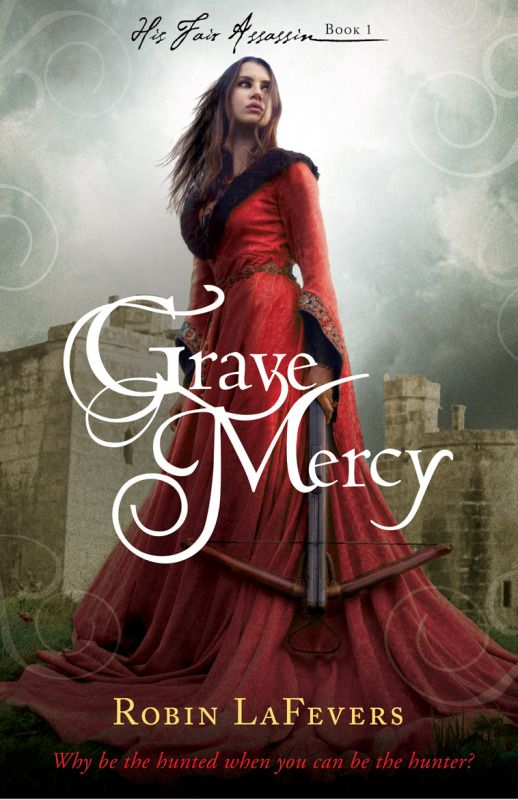Grave Mercy, book one in the His Fair Assassin trilogy, is a work of historical fantasy with a setting and cast of characters so believable you are left wondering just how much of the book is true. We ask author Robin LaFevers for answers!
 Historical accuracy of the setting…Grave Mercy is set on the very cusp of the Middle Ages and the Renaissance and all the major historical events and people in Grave Mercy are based on true events - from a twelve year old inheriting the duchy of Brittany, to her having been betrothed to at least a half a dozen suitors in return for the aid in Duke Francis II’s ongoing struggle with France.
Historical accuracy of the setting…Grave Mercy is set on the very cusp of the Middle Ages and the Renaissance and all the major historical events and people in Grave Mercy are based on true events - from a twelve year old inheriting the duchy of Brittany, to her having been betrothed to at least a half a dozen suitors in return for the aid in Duke Francis II’s ongoing struggle with France.Historical accuracy of religion portrayed in the book…While the nine old gods in Grave Mercy did not exist in the exact form they were portrayed, they were constructed from earlier Celtic gods and goddesses, about whom we know very little. I have added a few embellishments of my own.
Sadly, the convent of Saint Mortain does not exist except in my imagination, but the Ile de Seine was known to have been the home of the last nine druidesses who served the old gods and ways and bears a small, ancient chapel built right next to a pagan standing stone.
Historical accuracy of the plot…The political intrigue and switching alliances in the book was also historically accurate, although in the interest of not swamping the story—or the reader—I left quite a few additional alliances and machinations out. Suffice it to say there were about twice as many schemes going on in real life as I used in the book, including additional suitors, competing claims for the throne, and additional double crossing.
Just before his death, Duke Francis II was forced to sign the Treaty of Vergers, which gave France the right to approve any marriage Anne might make. Immediately upon his death, France sent emissaries to Anne’s court claiming that the French Regent would act as guardian and oversee both her and her kingdom. That was in direct violation of the Treaty of Vergers. And so Anne assumed the mantle of her father’s long battle for independence from France.
 Historical accuracy of characters…With the exception of one completely fictional character, all of Anne’s councilors in the
Historical accuracy of characters…With the exception of one completely fictional character, all of Anne’s councilors in thebook are actual historical figures, all of whom betrayed her in real life just as they did in
the book.
Anne had five ‘natural’ siblings, which was a polite word for bastards. The mother of her natural siblings had indeed been the mistress of the former king of France before becoming mistress to Duke Francis and bearing him five children. Gavriel Duval was not among them, for he is a wholly fictional character. Francois however, was one of Anne’s knights and did indeed swear fealty to her before a council of barons. One of the fictional liberties I have taken is having Madam Hivern still alive at the time of our story. In real life, she died before Anne was born.
Count d’Albret is also an historical figure. He was described by the chroniclers of his time as fifty years old, large and ugly, with many children from a previous marriage. He was also devious and cunning and by all accounts so repellent to Anne that she ultimately issued an edict proclaiming she would not marry him. For someone so dedicated to her country, this struck me as an extreme measure that made great fodder for the story.
Anne of Brittany was a real historic person. At twelve years old, upon the death of her father, she inherited one of the last remaining duchies in Western Europe. Groomed since birth to inherit the duchy, she was a remarkable girl by all accounts but her substantial inheritance was complicated by two things. One, she was a woman at a time when traditionally women did not inherit kingdoms. Since the time of Charlemagne, Salic Law had been invoked to prevent women from becoming rulers. When Anne became Duchess of Brittany, it defied all the conventions of that time. Secondly, and perhaps more importantly, not only was she unmarried, but her father had promised her hand in marriage to at least half a dozen European nobles, if not more. As he plotted and strategized, trying to keep his lands and title safe from the French Crown, he dangled his daughter (and her substantial dowry) as bait for the aid he needed from other princes and dukes. Consequently, when he died, she had been promised to more than one suitor. To say that this created problems for her in keeping her duchy independent is an understatement. Which is why she needed the help of assassin nuns. What? Doesn’t everybody call for assassin nuns when they’re having political difficulty? If not, they should…
Thank you, Robin, for the awesome guest post! It's so fascinating, and I'm now even more excited to read it! Be sure to check out Robin's website, and Grave Mercy, which will be released on 7th June 2012.
Hold up. Need more convincing to read the book? Then you may want to check out an extract, the Facebook page, the trailer below, and head on over to The Pewter Wolf tomorrow for the next stop on the tour!









0 comments:
Post a Comment